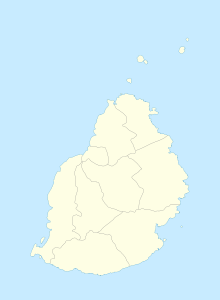Roches Noires
Coordinates: 20 ° 7 ′ S , 57 ° 43 ′ E
Roches Noires is a place ("Village") on Mauritius .
The northern part of Roches Noires belongs to the Rivière du Rempart district , the southern part is in the Flacq district . At the 2011 census, the place had 5,683 inhabitants. Both parts belong administratively to the Village Council Area Roches Noires.
As in the neighboring Plaines des Roches , the name of Roches Noires is derived from the basalt rocks that characterize the area (Roche is the French word for rock). The rocks originate from volcanic activity around 25,000 years ago. There are also caves here where the sea has washed away the softer stone and the remaining basalt formed the caves.
To the south of the village is the Parc national de Bras d'Eau , a piece of forest designated as a national park.
The coastal strip of Roches Noires originated as a fishing village and is now used for tourism. There are a number of sandy beaches with hotels and holiday properties along the B 15 coastal road. There is an open marina in the village itself.
On November 28, 1987 tried a Boeing 747 of South African Airways , on the regular flight from Taiwan to South Africa , after a fire outbreak in the cargo hold an emergency landing in Mauritius. This failed and the machine crashed into the sea off Roches Noires. All 159 people on board died. Roches Noires hit the headlines as early as July 1964 due to an accident: 5 soldiers from the Special Mobile Forces were dragged into the sea by the waves during a maneuver and drowned.
literature
- Benjamin Moutou: Pamplemousses - Rivière du Rempart - Quatre siècles d'histoire, 2006, ISBN 978-99903-992-9-5 , SS 326–327
Individual evidence
- ↑ Statistics Mauritius: Housing and population census 2011 , Volume II: Demographic and fertility characteristics , pp. 71-72, statsmauritius.govmu.org (PDF): Only the population figures in the northern part are mentioned, the southern part seems to be uninhabited.
